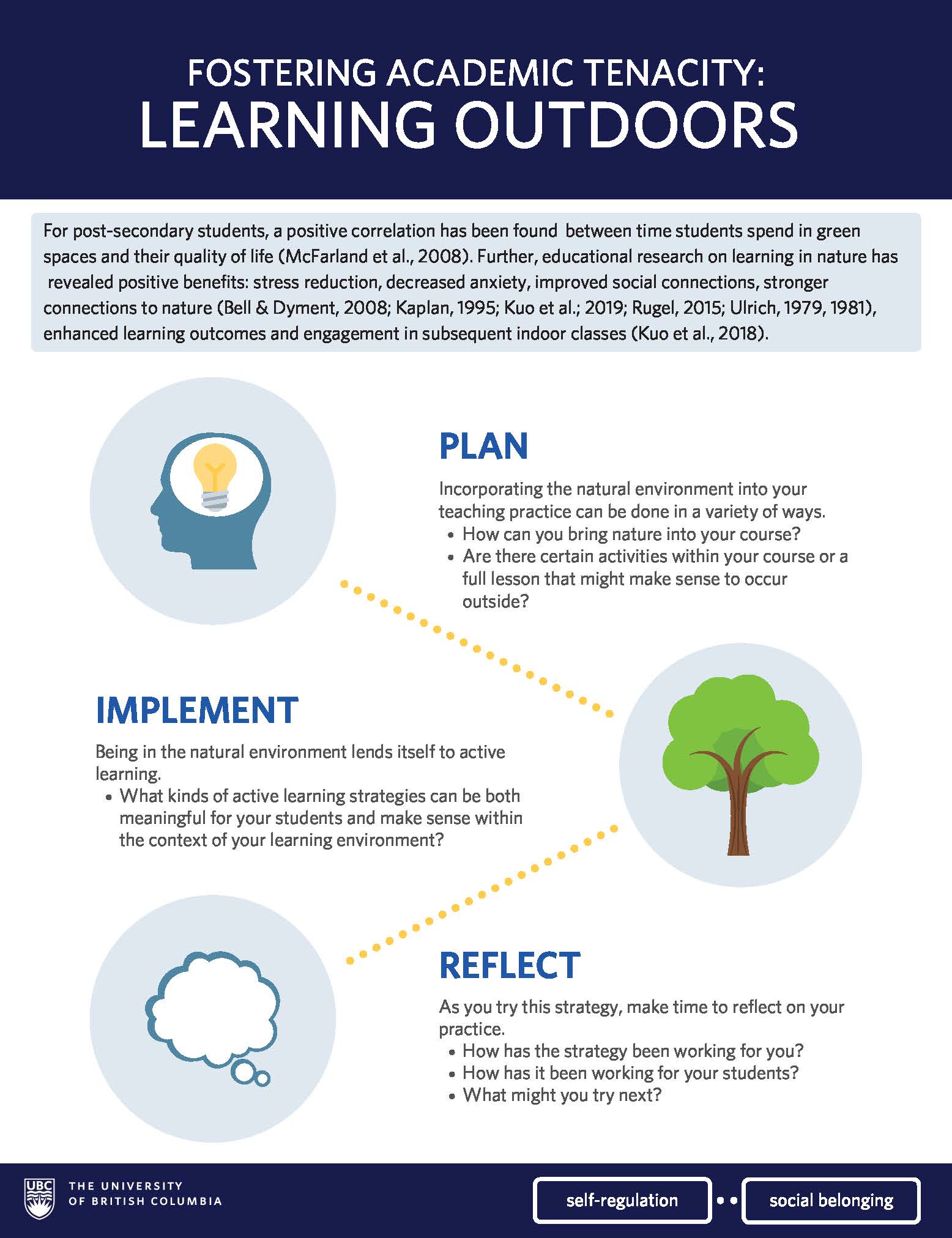Taking Learning Outdoors in Nature
For post-secondary students, a positive correlation has been found between the time students spend in green spaces and their quality of life (McFarland et al., 2008). Further, K-12 educational research on learning in nature has revealed positive benefits: stress reduction, decreased anxiety, improved social connections, stronger connections to nature, (Bell & Dyment, 2008; Kaplan, 1995; Kuo et al., 2019; Rugel, 2015; Ulrich, 1979, 1981), enhanced learning outcomes, and engagement in subsequent indoor classes (Kuo et al., 2018).
Promising Practice
Katie Lee Bunting teaches in the Department of Occupational Science and Occupational Therapy. As part of the Master of Occupational Therapy program, Katie teaches OSOT 511 Fundamentals of Occupational Therapy. In this course students learn the Kawa Model (Iwama et al., 2009), an occupational therapy conceptual model that uses a river as a metaphor for life. Outdoor education and place-based pedagogies are employed in the delivery of this lesson. Class takes place in the Nitobe Memorial Garden and in an adjacent small forested area, where students work in small groups to apply the Kawa Model to a case study. Photography is also used, where students capture images that represent the Kawa Model as applied to the case. Throughout this lesson students have the opportunity to engage with their instructor, peers, and learning in a new environment.
The impact of learning in the natural environment for this lesson was assessed with the following two questions in mind: (1) How does learning in the natural environment affect students’ self-regulation, and students’ sense of connection to nature, campus, and their peers? (2) What features of the natural environment facilitate these effects?
Key findings included:
- After the outdoor lesson, survey findings showed statistically significant increases in student-reported mindfulness and academic buoyancy scores.
- In face-to-face interviews, students described how learning in nature:
- provided multi-sensory regulating experiences that improved their energy and focus
- facilitated deeper learning and engagement with class content
- fostered a stronger sense of connection to campus and each other is valued and they would like to learn outdoors in nature more often.
Selected References and Measures
- Bell, A. C., & Dyment, J. E. (2008). Grounds for health: the intersection of green school grounds and health‐promoting schools. Environmental Education Research, 14(1), 77-90.
- Kaplan, S. (1995). The restorative benefits of nature: Toward an integrative framework. Journal of Environmental Psychology, 15(3), 169-182.
- Kuo, M., Browning, M. H., & Penner, M. L. (2018). Do lessons in nature boost subsequent classroom engagement? Refueling students in flight. Frontiers in Psychology, 8, 2253.
- Kuo M., Barnes M., and Jordan C., (2019). Do experiences with nature promote Learning? Converging evidence of a cause-and-effect relationship. Frontiers in Psychology,10, 1-9.
- Rugel, E. (2015). Green space and mental health: Pathways, impacts, and gaps. National Collaborating
- Centre for Environmental Health.
- Ulrich, R. S. (1979). Visual landscapes and psychological well‐being. Landscape Research, 4(1), 17-23.
- Ulrich, R. S. (1981). Natural versus urban scenes: Some psychophysiological effects. Environment and Behavior,13(5), 523-556.
- Martin, A. J., & Marsh, H. W. (2008). Academic buoyancy: Towards an understanding of students' everyday academic resilience. Journal of School Psychology, 46(1), 53-83.
- Schultz, P. W. (2001). The structure of environmental concern: Concern for self, other people, and the biosphere. Journal of Environmental Psychology, 21(4), 327-339.
- Tanay, G., & Bernstein, A. (2013). State Mindfulness Scale (SMS): Development and initial validation. Psychological Assessment, 25(4), 1286.
- Tovar, E., & Simon, M. A. (2010). Factorial structure and invariance analysis of the sense of belonging scales. Measurement and Evaluation in Counseling and Development, 43(3), 199-217.
- The University of British Columbia. (2018). The undergraduate experience survey 2018.
- Zandvliet, D. B. (2014). PLACES and SPACES: Case studies in the evaluation of post-secondary, place-based learning environments. Studies in Educational Evaluation, 41, 18-28.
Go Further

Recommended Citation: Health Promotion & Education, UBC. (2019). Fostering academic tenacity: Taking learning outdoors. Retrieved from: wellbeing.ubc.ca/wble
We gratefully acknowledge the financial support for this project provided by UBC Vancouver students via the Teaching and Learning Enhancement Fund.